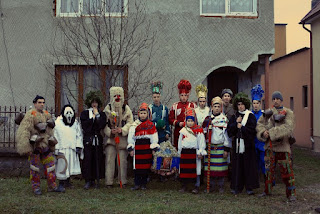Captives (1970)
was Norman Manea’s first novel, written in opaque prose that mirrored the
difficulties of coming to terms with everyday reality in a repressive society,
and it makes no concessions to the reader.
The novel tracks life in post-war Romania, with its legacy of trauma,
omnipresent surveillance and lack of trust, its petty bureaucracy, the fear of
falling foul of a regime which considers private life to be its business, the
unreliability of surface appearances, and lack of autonomy. Romania is depicted as a fractured place that
had spun from fascism to communism, always at the behest of larger, stronger
powers. Survival means accommodation, even
when this entails hypocrisy, an effort unfortunately resulting in psychic
damage. A key motif is the necessity of
amnesia to be able to cope with the present.
The narrative is divided into
three sections, ‘She’, ‘You’, and ‘I’, and follows three characters who collectively
reflect Romania’s recent history and demonstrate the dismissive way the
individual is treated. ‘She’ is Monica
Smântănescu, a struggling French and piano teacher frustrated by the rudeness
of her clients. She refers to Handel’s Chaconne
in G Major, a piece comprising continuous variations, which symbolises the
circular nature of her life and those of others who are trapped and not able to
develop. ‘You’ is the daughter of a Romanian
army officer, Captain Zubcu, who fought for the Nazis and returns suffering
from PTSD. He cannot free himself from
his experiences, possibly including war crimes, and commits suicide by throwing
himself into a vat of liquid metal. His
daughter experiences extreme grief, plus the pain of a broken love affair with
the narrator.
‘I’, the narrator, is an engineer
looking back on his early political activities, his mind eventually unravelling
after fruitlessly attempting to do what is required of him by the state. There is a suggestion he is a Jewish
Holocaust survivor, though this is not made explicit. He describes his childhood years, and his
extreme adherence to the party, his political orthodoxy more to demonstrate a
sense of superiority than the result of ideological inclination. As a member of the Pioneer Organisation he is
keen to root out incorrect opinions, particularly his friend Sebastian Caba’s. Later Caba becomes his boss at the
engineering company.
The three sections are not
discrete but shift and blend, throwing up connections which may or may not be
correct. The oblique narrative spirals
round in addressing social conditions and their psychological impact, forming a
hermetic container reflecting airless times that feel damp, grimy and stressful. We can never be sure who is a reliable
narrator and we may read about the same event from differing perspectives. If people cannot be honest with themselves,
how can they be honest with others? The
result is a fracture of personality, reflected in the novel’s style. Social interactions are low and dishonest and
the appropriate response to an absurd situation is absurd behaviour. Whatever the differences in the three
characters’ experiences, they are all captives, both externally through the
political repression circumscribing the citizen’s rights, but also internally,
by consenting to it.
Manea’s introduction to the 2015
English translation supplies some background to the novel’s creation. It was intended as a gauntlet thrown down to
the regime: far from embodying the values of the New Socialist Man, his
characters would be depicted more realistically as ‘vulnerable, weak, and
defeated individuals’, ‘wounded outsiders.’
It is a helplessness reinforced by the use of the passive voice, with
agency often difficult to assign, thereby becoming diffuse and externalised. Manea admits that the experimental form he
adopted is challenging and was influenced by the Nouveau Roman (presumably including the emphasis on the fallibility
of memory), but justifies it by citing Faulkner’s observation that a writer
should be judged by risks taken. He refers
to Kafka’s In the Penal Colony, with
‘additional local ambiguities, corruption, double-talk, and double-dealing.’
Translator Jean Harris’s
afterword outlines the challenges she faced, notably the novel’s allusive
language to describe ‘unhinged’ characters ‘cut loose from their moorings’, making
the meaning sometimes impossible to pin down, and Manea’s tendency to avoid the
use of pronouns. She notes that some
things are not said outright but hinted at, such as references to Jews, and survivor
guilt influencing behaviour. Significantly a very young Manea and his
family were imprisoned in a concentration camp in Transnistria during the war.
Captives is a
difficult read (Manea states he has made minor edits to the new edition for
clarity, so heaven knows what the original was like) and it is remarkable the
novel passed the censors, so far is it from socialist realism. There may not have been anything specific the
authorities considered subversive, but the cumulative effect is to show an
oppressive (in its different senses) world off-kilter and unhealthy, creating
alienation in its victims. In a state
that suppressed overt criticism, such indirectly expressed dissident writings
were the best those who questioned the legitimacy of the regime’s behaviour
could hope for, but Manea transcended the limitations to achieve a memorable,
if frequently confusing, work of fiction.















